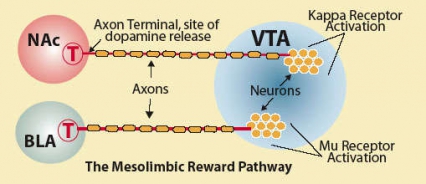NIDA-supported neuroanatomists have shown that the neurons that deliver dopamine to two regions of the brain's mesolimbic reward system respond differently to opioids. The finding adds to scientists' evolving picture of a key system in the brain's response to drugs, reveals opportunities for more detailed investigations, and may eventually enable pharmacologists to develop medications to specifically target each of the regions.
Dr. John T. Williams and colleagues at Oregon Health Sciences University (OHSU) studied neurons that originate in the brain's ventral tegmental area (VTA) and release dopamine in the nucleus accumbens (NAc) and the basolateral amygdala (BLA). Dopamine release in the NAc is the biochemical source of our feelings of pleasure and reward when we achieve a goal, as well as the highs produced by opioids and other drugs of abuse. However, less is known about the role of the BLA or the regional dynamics of the system as a whole.
The OHSU team showed that the VTA neurons that serve the NAc were inhibited more when an opioid compound was used to stimulate kappa receptors; VTA neurons that serve the BLA responded more to mu opioid activation. Opioid compounds, including medications and illicit drugs, stimulate both kappa and mu receptors, but they vary in the intensity with which they stimulate each. The magnitudes of each compound's intensities of kappa and mu activation contribute to its distinct properties in comparison with other opioids—for example, variations in pain control and addictivity.
"The main import of our work is that it should be possible to selectively regulate dopamine-releasing neurons in the nucleus accumbens and amygdala," Dr. Williams says. If researchers can raise dopamine levels in the NAc while holding them steady in the BLA, or vice versa, they will be able to elucidate each region's separate role in the response to opioids and—more generally—in promoting a wide variety of experiences and behaviors.
Filling in the Mesolimbic Map
The researchers first mapped the sets of neurons serving the NAc and BLA of laboratory mice using fluorescent microspheres. Injected into either the NAc or BLA of each animal, the microspheres entered neurons at the axon terminals—where neurons release neurochemicals like dopamine—and migrated along the axons to the neuronal cell bodies in the VTA. When the researchers examined brain slices from the animals, the pattern of fluorescence revealed that the neurons serving the NAc had their cell bodies in one part of the VTA—the posterior/medial portion—while those that went to the BLA originated in the anterior/lateral region.
To confirm that the fluorescent neurons really were the type that produces dopamine, the researchers tested for the presence of an enzyme that is a marker for such cells. They found sufficient quantities of tyrosine hydrolase, which aids dopamine synthesis, to conclude the affirmative.
Next, the investigators examined the neurons' functional characteristics. "We hypothesized that because these target areas serve different functions, the neurons projecting to them would exhibit different properties," Dr. Williams says. In particular, they looked at the kappa and mu opioid receptors on the neurons' cell bodies. When the VTA was exposed to a chemical—U695930—that stimulates only kappa receptors, the neurons projecting to the NAc conveyed a stronger inhibitory current, as measured in picoamperes (10-9 ampere), than did those that projected to the BLA. The application of [Met] enkephalin (ME), which activates mu receptors, had the opposite effect: it generated a stronger current in the neurons going to the BLA than those going to the NAc.
 Mapping Neuronal Circuitry: Researchers injected fluorescent microspheres into the nucleus accumbens (NAc) and the basolateral amygdala (BLA) of mouse brains in order to track dopamine pathways back to two separate points of origin within the ventral tegmental area (VTA).
Mapping Neuronal Circuitry: Researchers injected fluorescent microspheres into the nucleus accumbens (NAc) and the basolateral amygdala (BLA) of mouse brains in order to track dopamine pathways back to two separate points of origin within the ventral tegmental area (VTA)."Studying the brain disease of addiction involves looking for chronic dysfunction in the brain's reward and motivational pathways," comments Dr. Woody Lin of NIDA's Division of Basic Neuroscience and Behavioral Research. "To understand how drugs modify this circuitry, we need to know how it functions normally. This research gives us a better understanding of how specific brain regions function, and provides insights into potentially important sites for intervention." In terms of developing medications to treat substance abuse, the OHSU team's work suggests that it may be possible to alter specific aspects of the response to drugs by regulating release in one or the other part of the mesolimbic reward system.
Source
Ford, C.P.; Mark, G.P.; and Williams, J.T. Properties and opioid inhibition of mesolimbic dopamine neurons vary according to target location. Journal of Neuroscience 26(10):2788-2797, 2006. [Full Text (PDF, 521KB)]
